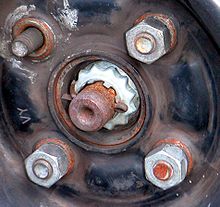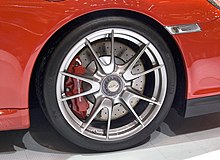Wheel bolt and wheel nut

As wheel bolts and wheel nuts , the connecting elements screws or nuts are referred to, with which the wheels are attached to the hub flanges of multi-track motor vehicles and trailers. Wheel nuts are screwed onto studs attached to the hubs . Wheel bolts are screwed into an internal thread on the hub. In German car wheel bolts are mainly used, even Studs called for Asian models usually lug nuts.
Shaping of the connecting elements
In the following, only the term wheel nuts is used, even if the corresponding statement for wheel bolts applies as well.
Wheel nuts have a conical (often 60 °), partially spherical or flat contact surface with the edge of the hole in the wheel flange. In older vehicles, the conical or part-spherical surface was necessary to achieve the centering of the wheel. In newer vehicles, the wheel disc is centered via its center hole on the hub, so that centering via the wheel nuts is no longer necessary and flat collar nuts are often used. The wheel nut must always match the rim used. If the shape is incorrect, there is a risk that the nuts will loosen while driving.
For loosening or tightening the wheel nuts generally one is wheel cross or a socket wrench in hexagonal shape with the appropriate key length used. Workshops mostly use pneumatic screwdrivers .
In the case of steel wheels, the edge of the hole for the wheel bolt is tapered and yields elastically when tightened. This creates a self-locking elastic screw connection similar to an expansion screw connection.
Cast aluminum wheels lack these elastic elements. For this they usually have longer through holes than steel wheels. The increased clamping length in this way requires a screw with a longer shaft, which causes the desired elastic expansion .
Different circle diameters are used for the arrangement of the fastening points, which are preceded by the number of holes in corresponding, abbreviated designations, for example 4 × 98 (smallest usual bolt circle : 98 mm ≈ 4 inches ) and 6 × 139.7 (largest usual bolt circle: 5.5 inches). On cars, four to five, previously also three, wheel nuts per wheel are common; on buses, trucks and agricultural machinery, more than five wheel nuts are common.
Wheel nuts can be designed with different threads and wrench sizes. In Europe, for example, M14 screws with a wrench size of 17 or 19 mm are usually found, while vehicles from Japanese manufacturers have M12 × 1.5 (thread diameter × pitch) and wrench size 21. M12 x 1.25 with a wrench size of 17 mm is also common.
Protection against theft
To make the theft of high-quality aluminum wheels and tires more difficult, for example, there are screw or nut sets (sets) with special heads, so-called rim locks , which cannot be loosened with a hexagon but only with a special key. One of these special shapes is sufficient for each wheel.
Tightening torque
Since the wheel nuts hold the wheel on the hub flange and thus on the vehicle, it is important that the wheel nuts are tightened with the correct torque . It is therefore advisable to retighten each nut with the torque wrench after tightening the wheel nuts with the pneumatic screwdriver (or a comparable tool) . After every wheel change, the correct tightening torque of the wheel nuts should be checked again after a short journey (e.g. 50 km). Some workshops therefore leave a note in the car as a reminder after dismantling a wheel. The exact torque value essentially depends on the type of thread, type of wheel and the materials used. For cars, a torque of between 85 and 200 Newton meters (Nm) is usually specified in the technical documentation.
Protection against contact corrosion
Corroded wheel nuts often cause problems when changing a wheel, so that in the event of a flat tire while traveling, it may be impossible to change a tire with the tool supplied in the car without the help of others. A wheel spider or a tool with an extra long lever is required for this.
Few manufacturers, for example Porsche, allow special lubricants on the thread or the contact surfaces. In general, in the absence of specific information, it can be assumed that the thread and cone must not be lubricated. The tightening torques specified by the manufacturer only apply to screws that are not greased. Corroded surfaces should then only be derusted with a wire brush .
Normal lubricating grease is not suitable for preventing the nuts from rusting up, as the temperatures in the vicinity of the brake discs are too high. A hot screw compound such as ceramic or copper paste, which also contains temperature-stable particles as pressure and shear-resistant release agents, is more suitable .
Central locking
For particularly quick wheel changes (as required in motorsport, for example), most racing cars and some sports cars such as the Porsche 997 GT3 3.8 have a central nut or central screw, usually referred to as a "central lock" . By loosening or tightening this single nut or screw, a single wheel can be removed or attached to the car.
As a special feature, central locks are usually tightened against the direction of rotation of the wheel. On the right-hand side of the vehicle, the connecting elements then have left-hand threads.
Norms and standards
- DIN 74361 - Disc wheels for motor vehicles and trailers
Individual evidence
- ↑ Assembly and functional description of the Zeta-Centerlocksystem. (PDF, 565 kB) T-Tool Precision GmbH, December 21, 2015, accessed on June 28, 2017 .

